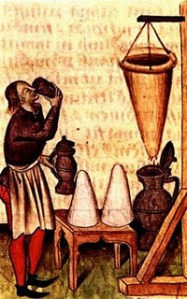There is nothing better to warm your cockles during Christmastime than a bit of mulled wine. If you have never tried it or heard of it, then you are certainly missing out on something. Mulled wine is essentially hot, sweetened red wine made aromatic with the addition of citrus fruits and warming spices such as cloves, cinnamon and nutmeg. It’s history goes right back to the Ancient Greeks.
Before mulled wine was the drink hippocras, which was supposedly invented by the Greek scientist and Father of Medicine, Hippocrates. The idea being that it was something of a tonic. The wine was either red or white and not necessarily hot either, but it was spiced and sweetened with honey. In Britain, the drink was very popular and there are several recipes for it. Here’s one from The Good Housewife’s Jewel by Thomas Dawson (1596):
To make Hypocrace
Take a gallon of white wine, sugar two pounds, of cinnamon, ginger, long pepper, mace not bruised galingall [sic]…and cloves not bruised. You must bruise every kind of spice a little and put them in an earthen pot all day. And then cast them through your bags two times or more as you see cause. And so drink it.
Not heating it up obviously meant you had plan a little ahead if you wanted to have a few goblets of hippocras at your Tudor feast.
By the seventeenth century, mulled wine recipes start to appear such as this eighteenth century recipe from Elizabeth Raffald in The Experienced English Housekeeper:
Grate half a nutmeg into a pint of wine and sweeten it to your taste with loaf sugar. Set it over the fire and when it boils take it off to cool. Beat the yolks of four eggs exceedingly well, add to them a little cold wine, then mix them carefully with your hot wine a little at a time. Then pour it backwards and forwards several times until it looks fine and bright. The set it on the fire and heat it a little at a time for several times till it is quite hot and pretty thick, and pour it backwards and forwards several times. Then send it in chocolate cups and serve it with dry toast cut in long narrow pieces.
It is strange that the Tudor recipe actually seems more like modern mulled wine that the newer one.
If you like the blogs and podcast I produce, please consider treating me to a virtual coffee or pint, or even a £3 monthly subscription: follow this link for more information.
Well here is my recipe for mulled wine – it is difficult to add quantities as you add most things to taste. It is also quite difficult to give an official list of ingredients; you can add any warm spice you like really (I expect a blade of mace would be an excellent addition, though I have never tried it), so this recipe is more a guideline than anything.
Ingredients
2 bottles of red wine, good but not great
¼ pint of brandy
½ pint of water
2 oranges, sliced
1 lemon, sliced
2 sticks of cinnamon
½ a nutmeg broken into several pieces
5 cloves
at least 4 tablespoons sugar
In a large saucepan, add all the ingredients and slowly heat the wine, stirring every now and again to dissolve the sugar and get the flavours dispersed.
It is important not to let the mulled wine boil as the alcohol will evaporate and we don’t want that. Taste, and add more brandy, sugar or water if you think it needs it. Keep the mulled wine on the lowest heat possible to keep warm and ladle into mugs or glasses.




Pingback: Mulled Cider | British Food: A History
Pingback: A Very Foodie Christmas - Chocolate (b)log
Pingback: Smoking Bishop | British Food: A History
Pingback: Opera Drink Pairing: Falstaff + Mulled Wine – Trills and Trouble
Pingback: Mulled Wine With A Twist | NoDishrespect